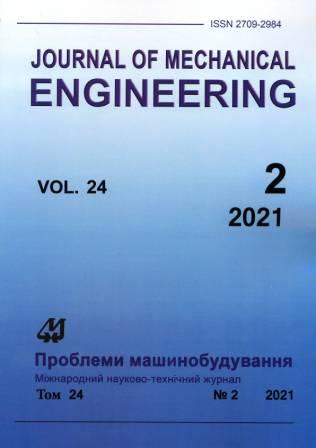Investigation of the Thermal Strength of Steam Turbine Diaphragms with Reduction of Axial Dimensions
Abstract
The problem of reducing the axial dimensions of steam turbine diaphragms is associated with the problem of steam turbine modernization performed by increasing the number of reactive blading stages and using existing foundations. Evaluation of the suitability of diaphragm design versions with established steam flow characteristics was carried out with constraints on short- and long-term strength conditions, as well as the accumulation of axial deflections due to creep. For computational research, there was introduced a methodology using the finite element method and Yu. M. Rabotnov’s theory of strain aging. The calculation of creep was reduced to solving an elastic-plastic problem with a deformation curve, which was represented by an isochronous creep curve for the time chosen. A software was used providing for the automated construction of the original computer diaphragm model with the help of guide-vane profile drawings and axial cross-sections of the diaphragm rim and body, as well as several geometric parameters. The calculated model of a welded diaphragm reproduces the main essential features of the structure, the material properties of its elements, as well as steam load. The exploratory studies of diaphragms with reduced axial dimensions were performed on the example of the second- and third-stage diaphragms of the high-pressure cylinder of the K-325-23.5 steam turbine. The original second- and third-stage diaphragm designs were considered to be basic, in relation to which, according to strength and rigidity parameters, the alternative ones were compared. Calculated data for the basic diaphragm design versions for 100 thousand operating hours were obtained. According to the calculations, maximum deflections are achieved at diaphragm edges, and the stresses, that are maximum at the points where the guide vanes are attached to the diaphragm rim and body, undergo a significant redistribution due to creep. Two approaches to the reduction of the axial dimensions of the second-stage diaphragm design of the steam turbine high pressure cylinder were involved. In the first approach, the reduction of the dimensions was achieved by proportionally reducing the guide-vane profile with a corresponding increase in the number of the guide vanes. In the second approach, the profile remained unchanged, but the axial dimensions of the diaphragm rim and body were reduced. The parameters of strength both in the elastic state at the beginning of operation and in the conditions of creep, as well as the accumulation of axial deflections were investigated. Based on the comparisons with the basic design, it was established that the second approach is more effective. Additional recommendations for the use of more heat-resistant steels for outlet guide vanes and the conditions of diaphragm attachment in the turbine casing are given.
Downloads
Published
Issue
Section
License
Copyright (c) 2021 Б. Ф. Зайцев, В. Л. Швецов, А. Н. Губский, С. А. Пальков, Т. В. Протасова

This work is licensed under a Creative Commons Attribution-NoDerivatives 4.0 International License.
All authors agree with the following conditions:
- The authors reserve the right to claim authorship of their work and transfer to the journal the right of first publication of the work under the license agreement (the agreement).
- Authors have a right to conclude independently additional agreement on non-exclusive spreading the work in the form in which it was published by the jpurnal (for example, to place the work in institution repository or to publish as a part of a monograph), providing a link to the first publication of the work in this journal.
- Journal policy allows authors to place the manuscript in the Internet (for example, in the institution repository or on a personal web sites) both before its submission to the editorial board and during its editorial processing, as this ensures the productive scientific discussion and impact positively on the efficiency and dynamics of citation of published work (see The Effect of Open Access).

